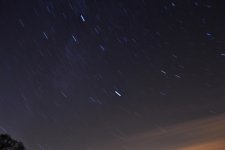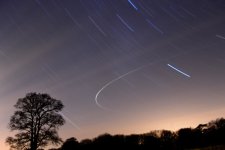You are using an out of date browser. It may not display this or other websites correctly.
You should upgrade or use an alternative browser.
You should upgrade or use an alternative browser.
Night time photography
- Thread starter fluorescentsam
- Start date
fluorescentsam
Senior Member
exposure 3096.7 seconds and yes it was at f/36
Scott Murray
Senior Member
Firstly why are you shooting at f/36? I would say that they are smudges but in reality you do not need to go above f/11 for night shots and even then wide open is normally best depending on your lens etc.
BackdoorArts
Senior Member
While I can't see specifically what you're speaking of, you have made an image where the shutter was activated for more than 51 minutes. If you read your manual you will see that after a certain period of time (far less than that) an active sensor can build up enough heat that you will get hot pixels and sensor noise. Nikon has installed hard stops on video features at 20-25 minutes to protect sensors from potential damage. Your shot is more than twice that length.
I'm not saying you damaged your sensor, but I am saying that you exposed it to potential damage from overheating. What you see is likely noise from an overheated sensor.
There are many tutorials on shooting things like star trails, which is what I'm assuming you were going for, all of which involve the merging of multiple shorter exposures at higher ISO and wider aperture. That's probably the way to go.
I'm not saying you damaged your sensor, but I am saying that you exposed it to potential damage from overheating. What you see is likely noise from an overheated sensor.
There are many tutorials on shooting things like star trails, which is what I'm assuming you were going for, all of which involve the merging of multiple shorter exposures at higher ISO and wider aperture. That's probably the way to go.
Shooting at f/36 will certainly show any small dust specks on the front of your lens, if you shoot wider you won't see them as others have said.
Dust on the front of the lens does not show on a picture. They would only make the picture softer or produce more flare if the shot was backlit. Dust on the sensor on the other end will show more if the lens aperture is smaller, usually from f11-22. The dust on the sensor is seen as a black or darker spot and can usually be seen more in the blue sky portion of the pictures or on an even colored surface.
fluorescentsam
Senior Member
i was trying to get an effect like this http://www.photographymad.com/files/images/short-exposure-star-trail.jpg i thought a low iso and f/stop would stop the picture over exposing, i will try again tonight after reading a bit more, also i think the sensor is fine as i took some pictures today and they were fine.
Scott Murray
Senior Member
Here is a list of settings you would need to use at several common apertures to get a 30 second exposure:
f/1.4 and ISO400 = 30s
f/2.8 and ISO1600 = 30s
f/4.0 and ISO3200 = 30s
f/5.6 and ISO6400 = 30s
It goes without saying (but I’m going to say it anyways) you really want to try to get your hands on the fastest lens you can (largest aperture, smallest “F” number). These are just a good base to start with, once you frame your shot and take a few test shots, you will probably need to play around with the ISO to get the proper exposure.
Then you will need to start taking 30sec exposures over the next few hours to get star trails, this will require merging/stacking in PS etc.
Or if you would like only a single exposure try, f/4 ISO 100, 2 min.
f/1.4 and ISO400 = 30s
f/2.8 and ISO1600 = 30s
f/4.0 and ISO3200 = 30s
f/5.6 and ISO6400 = 30s
It goes without saying (but I’m going to say it anyways) you really want to try to get your hands on the fastest lens you can (largest aperture, smallest “F” number). These are just a good base to start with, once you frame your shot and take a few test shots, you will probably need to play around with the ISO to get the proper exposure.
Then you will need to start taking 30sec exposures over the next few hours to get star trails, this will require merging/stacking in PS etc.
Or if you would like only a single exposure try, f/4 ISO 100, 2 min.
Last edited:
Have a read of this and try the free software it works great.
StarStaX - www.starstax.net
Here is my first go using this software posted a few months ago on nikonites.
http://nikonites.com/low-light-night/16886-my-first-star-trail.html#axzz2ogm0CeT1
StarStaX - www.starstax.net
Here is my first go using this software posted a few months ago on nikonites.
http://nikonites.com/low-light-night/16886-my-first-star-trail.html#axzz2ogm0CeT1
fluorescentsam
Senior Member
can you set a camera to automatically do intevals or do u have to go out every couple of seconds?
fluorescentsam
Senior Member
fluorescentsam
Senior Member
can you set a camera to automatically do intervals or do you have to go out every couple of seconds?
Scott Murray
Senior Member
You would need to get an interval timer for it, the D3100 doesn't have it built in.can you set a camera to automatically do intervals or do you have to go out every couple of seconds?



